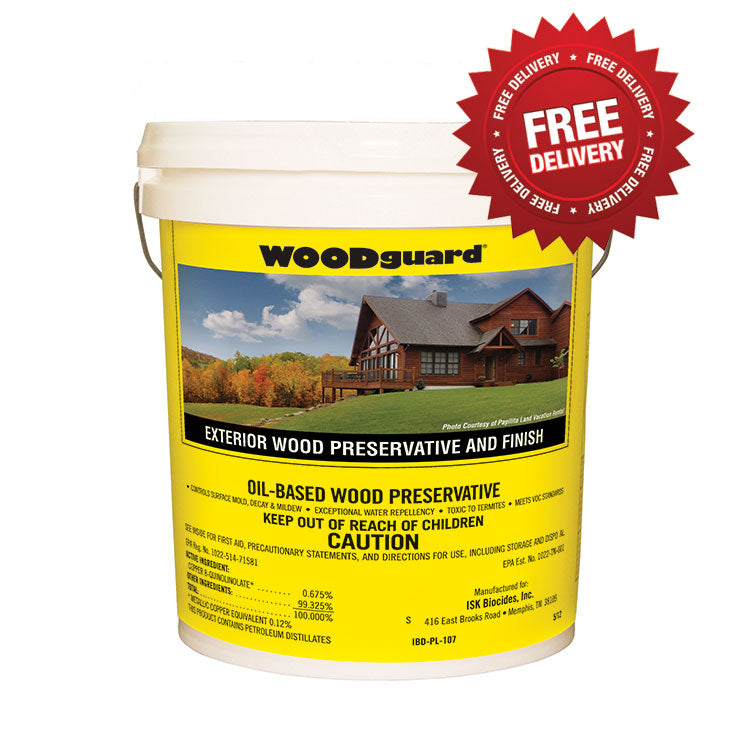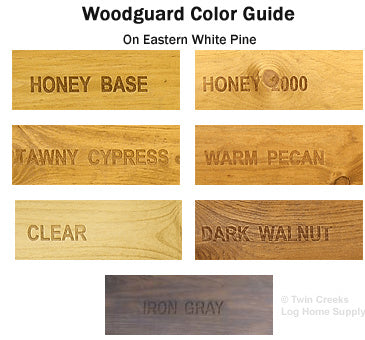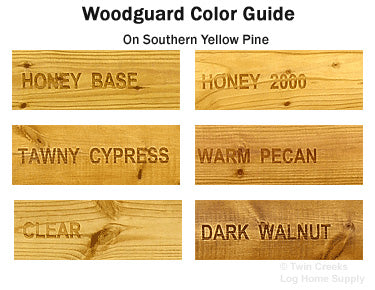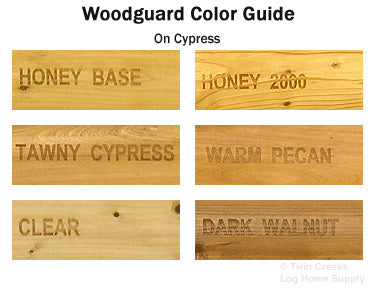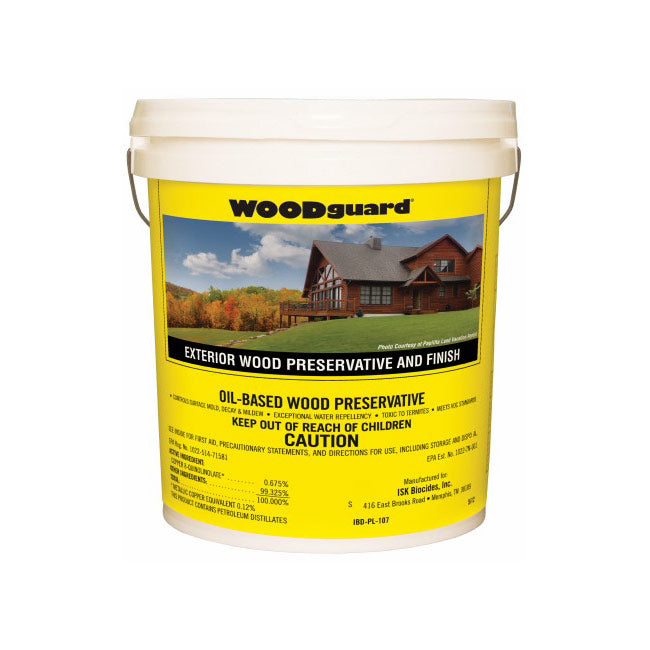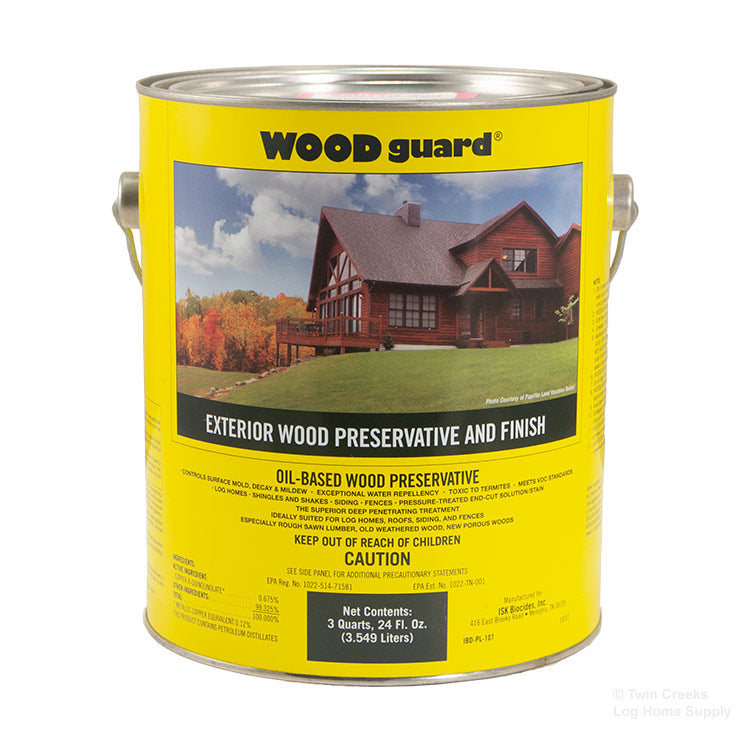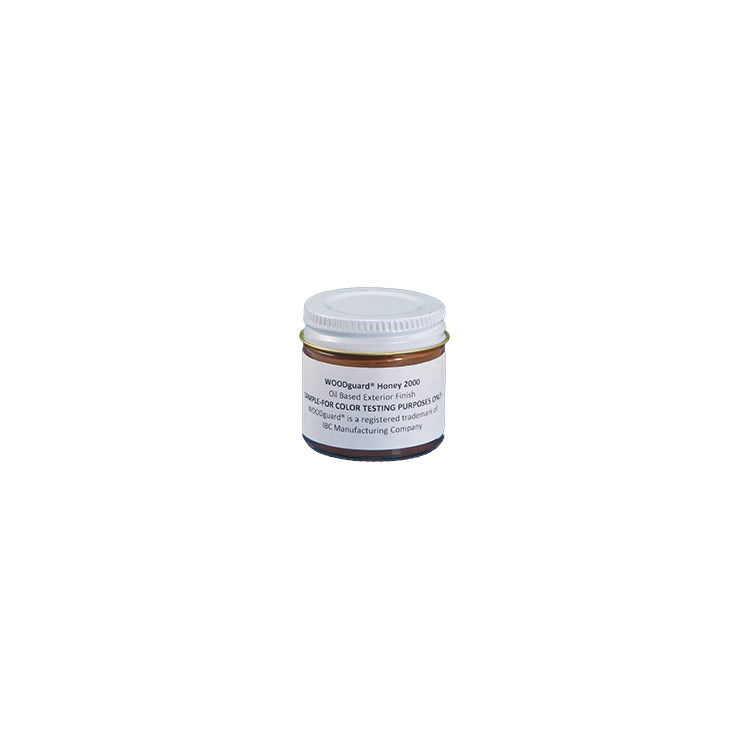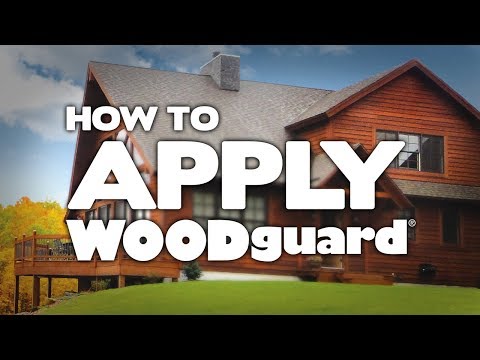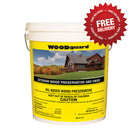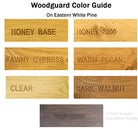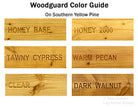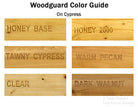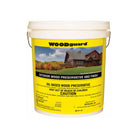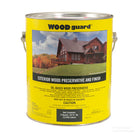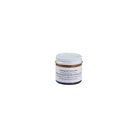Woodguard Stain
FREE SHIPPING ON 5 GALLON & 1 GALLON PAILS TO CONTINENTAL USA.
Details
Free Ground Shipping on 1 Gallon and 5 Gallon Pails
We are offering free shipping for 1 gallon and 5 gallon pails of this product purchased online and shipping to the Lower 48 United States. Offer does not apply to Alaska, Hawaii, and the US Territories. Free Shipping applies to this item only and not the entire order.
WoodGuard Exterior Stain is an oil-based exterior wood preservative for log homes, wood siding and shake shingles. WoodGuard protects against fading and discoloration due to decay, fungus and mold while providing water repellency by penetrating deeply into the wood. Only one coat is needed with this quality product that begins protecting wood with the first application.
WoodGuard also protects against cupping, curling and warping as well as insects such as powder post beetles and termites. WoodGuard is VOC compliant in all 50 states. The active ingredient, copper 8 quinolinolate is suitable for use on wood that may have incidental food contact.
WoodGuard Exterior Stain Features and Benefits
• Exceptional water repellency on sloping and vertical surfaces.
• One coat coverage. (Apply to the point of refusal.)
• Controls mold and decay as well as wood cupping and warping.
• Toxic to termites and anobiid powderpost beetles.
• Well suited for applications where environmental safety is needed.
• Active ingredient Copper 8-Quinolinolate will not photodegrade.
• Highly UV-stable.
WoodGuard Exterior Stain Recommended Usage
• WoodGuard can be used on siding, trim, doors, garage doors, windows, logs, fences.
• WoodGuard stain should not be used on and horizontal surfaces that may be walked on such as a deck. Please check out WoodGuard SWO or Sikkens Proluxe Cetol SRD if you are in need of a premium deck stain.

WoodGuard Stain Sample Cans
• We highly recommend that you try a sample can of any new stain color you are considering. The finished color of translucent stains can vary substantially based on species, texture, porosity of wood, and application technique. Sampling on your own wood is inexpensive and the best way to make sure you get the color you want for your home.
Product Resources:
• Woodguard Product Brochure
Specifications
More Information
|
Woodguard Application & Technical Resources: WoodGuard Exterior Stain Coverage Rate and Maintenance Coat Schedule WoodGuard Exterior Stain Application Methods WoodGuard Special Instructions for Decks WoodGuard Exterior Stain Surface Preparation Caulking Cracks, Checks, and Gaps: Checking Moisture Content Before Staining WoodGuard Exterior Stain Application Instructions WoodGuard Exterior Stain Do’s and Don’ts Application Don’t’s… WoodGuard Exterior Stain Clean Up and Storage WoodGuard Exterior Stain Maintenance Information CA Residents Prop 65: www.p65warnings.ca.gov |
Reviews
Product Questions
Product Questions
-
I recently had some locust steps put in as landscaping. They are big rough cut logs that are flat on top to be stairs. The landscaper recommended Woodguard and I just finished applying it to 25x 3 foot by 8 inch steps. I was checking the drying time and found this: WoodGuard Exterior • WoodGuard stain should not be used on and horizontal surfaces that may be walked on such as a deck. Please check out WoodGuard SWO or Sikkens Proluxe Cetol SRD if you are in need of a premium deck stain. So, why should it not be used on stairs?
Woodgurad is a slow drying penetrating oil that is only used on vertical surfaces. It is definitely not used for stair or deck applications. The SWO or Sikkens SRD are much better choices for your application.
-
How long is the shelf life
Woodguard has an expected shelf life of at least two (2) years storage at normal temperatures (up to 80°F, 27°C).
-
Can I use Woodguard over Boracare?
Boracare borate is a glycol based product which is not compatible with Woodguard so it is not recommended to use these two items together. I would suggest other borate solutions such as Tim-Bor or Armor Guard.
-
Can I apply clear woodguard over an oil based stain?
Hello,
I would not recommend this in most situations. Woodguard is an oil-based finish that is formulated to penetrate deep into the wood fibers. Most of the stains we see are coatings, which are formulated to leave a thin protective coat on the outside of the wood. If you try to apply Woodguard over an area that still has a coating intact, the coating will repel the Woodguard as it tries to penetrate the surface. Please call our office if you would like to explore options that may work better for you. -
Can I paint Woodguard over my old stain?
Woodguard is an exceptional oil-based penetrating oil which needs to applied over existing wood that has been stained with Woodguard or it needs to be applied directly to new wood. This stain needs to be able to soak into the wood fibers and not lay on top of another finish.
-
Can I get a 1 gallon pail of Woodguard Iron Gray?
I'm sorry, ISK Biocides currently only makes the Woodguard Iron Gray color in 5 gallon pails.
-
Will mixing the dark walnut Woodguard with the clear Woodguard stain lighten the color of the stain so it doesn't come out too dark on the logs?
You are correct. Mixing the Clear with the Dark Walnut should yield a more muted color than the Dark Walnut by itself. If you're looking for a medium brown color, you might want to sample the Honey 2000 or Tawny Cypress pre-mixed colors as well. We have free samples of all the Woodguard factory colors.
-
Can you apply Sand and Seal over Woodguard stain? Is it acceptable?
I would highly recommend against this combination. Some Sand and Seal formulations may adhere over the top of Woodguard, but you can expect all of them to interfere with maintenance coats of Woodguard in later years.
Most exterior wood stains are designed as coatings; that is, they will form a barrier at the surface of the wood that works like a flexible coat of armor. Coatings attempt to keep sun and rain from passing into the wood while allowing water vapor to escape from the coating when it's hot outside. You can think of this as being protection from the outside-in.
Woodguard is formulated differently in that it is a deep penetrating oil. Their intent is for the stain to dive deep into the wood fibers, leaving little barrier at the surface. This pre-saturates the cells so that any moisture that enters the wood should be expelled. This protects the wood from the inside-out.
When you need to do a maintenance coat of Woodguard several years later, a coating product like Sand and Seal will prevent the Woodguard from penetrating into the wood correctly. -
Is there a clear top coat I can do as a maintenance over Woodguard? Say, maybe 3 or 4 years down the road?
ISK Biocides makes a clear color option of Woodguard that you can use as a maintenance coat. It is the same product, just without any added pigment. Woodguard in Clear also has the same flat sheen level as the colors. Woodguard does not have a separate clear topcoat. Any coating that bonds at the surface of the wood can block Woodguard from penetrating deep into the wood fibers as intended.
-
Why does the Woodguard clear color have a green undertone?
Woodguard utilizes an active ingredient known as copper 8-quinolinolate to aid in preserving wood from mold and mildew. Because it is copper based, this ingredient has a naturally greenish appearance. You can typically only see its presence in the clear Woodguard as the green tint is masked by the pigments in all of the tinted color options. The untinted Woodguard does dry clear and does not leave a green tint to your wood project.
-
What is the gloss level expected if the clear is applied to weathered logs? High gloss or low gloss?
Woodguard is fairly unique in that it is a deep penetrating oil. This product was formulated to dive deep into the wood fiber in order to protect the wood from the inside out. By contrast, most finishes are formulated as coatings, and are intended to leave a thin, breathable barrier that will protect the wood from the outside in. Consequently, as the Woodguard moves beyond the wood surface, it will leave a matte (no/low sheen) finish, no matter whether the logs are new or weathered.
-
What is the color of the house shown on the Woodguard bucket?
Our company spoke with a representative at Woodguard's manufacturer who informed us that the Warm Pecan color was used on this house.
-
I last used Woodguard several years ago and have a couple of gallons left over. Will this still be good to use or should I discard it?
Woodguard has an exceptional shelf life so more than likely your leftover Woodguard should be just fine. When you get ready to restain, be sure and stir the older stain very well and then add it to your new product to blend or "box" the colors. If the older stain appears to be clumpy or thick, then I would suggest discarding it and proceed with new stain.
-
What does the Copper-8 Quinolinolate do?
Copper-8-Quinolinolate is an insecticide used for a variety of wood protection and preservation purposes. It is toxic to wood decay and insects, but has low toxicity to humans and animals. For further information, here is a link to an in-depth article by the U.S. Forest Service: http://www.fs.fed.us/t-d/pubs/htmlpubs/htm06772809/page02.htm.
-
Can this product be sprayed on with an airless sprayer? Also, what is the coverage per square foot for each gallon?
It is not recommended to spray on Woodguard with an airless sprayer because the product will not saturate the wood properly. Woodguard can be applied with a low-pressure or "pump-up" sprayer. When applying Woodguard with a sprayer, make sure that the nozzle it set to deliver a low-pressure, coarse spray.
Woodguard covers approximately 200 sq. ft/gal. on smooth wood. Woodguard stain should be applied to the point of refusal. -
How does Woodguard need to be applied? Is there a specific type brush that needs to be used?
Below are the recommended application instructions for Woodguard stain:
- Spray -- Low-pressure spray or "pump-up spray" equipment is suitable. Set nozzle to deliver a low-pressure, coarse spray. Do not use airless spray equipment.
- Brush -- A regular paintbrush is fine for most surfaces. For uneven or rough surfaces, use a stiff-bristle brush.
- Roller -- Use a long nap for rough surfaces. Apply Woodguard to the point of refusal (until it starts to run) and have someone follow to back brush the applied Woodguard to a smooth uniform coating.
| Features | |
|---|---|
Opacity Refers to how easily one can see through the stain. Translucent means that the wood grain is easily visible through the stain. Semi-transparent means that the wood grain is obscured by the pigment in the stain but is still visible.
|
|
Stain Base |
|
Stain Type Refers to how this stain was designed to work. Coatings form a flexible solid barrier on the outside of the surface to protect from the outside-in. Deep penetrating oils normally do not form a surface barrier and protect from the inside-out.
|
|
Product Type |
|
Sheen |
|
Coverage Rate Coverage rate can vary greatly depending on the texture of the surface. Please see description for full details.
|
|
Coats for First Application How many coats of this stain that are normally needed for the first application over bare wood.
|
|
Coats for Maintenance How many coats of this stain that are normally needed when the stain has weathered and is in need of a maintenance coat.
|
|
Clean-Up |
|
| Item | |
Brand |
Woodguard
|
Size |
1 Gallon
|
Color |
Clear
|

